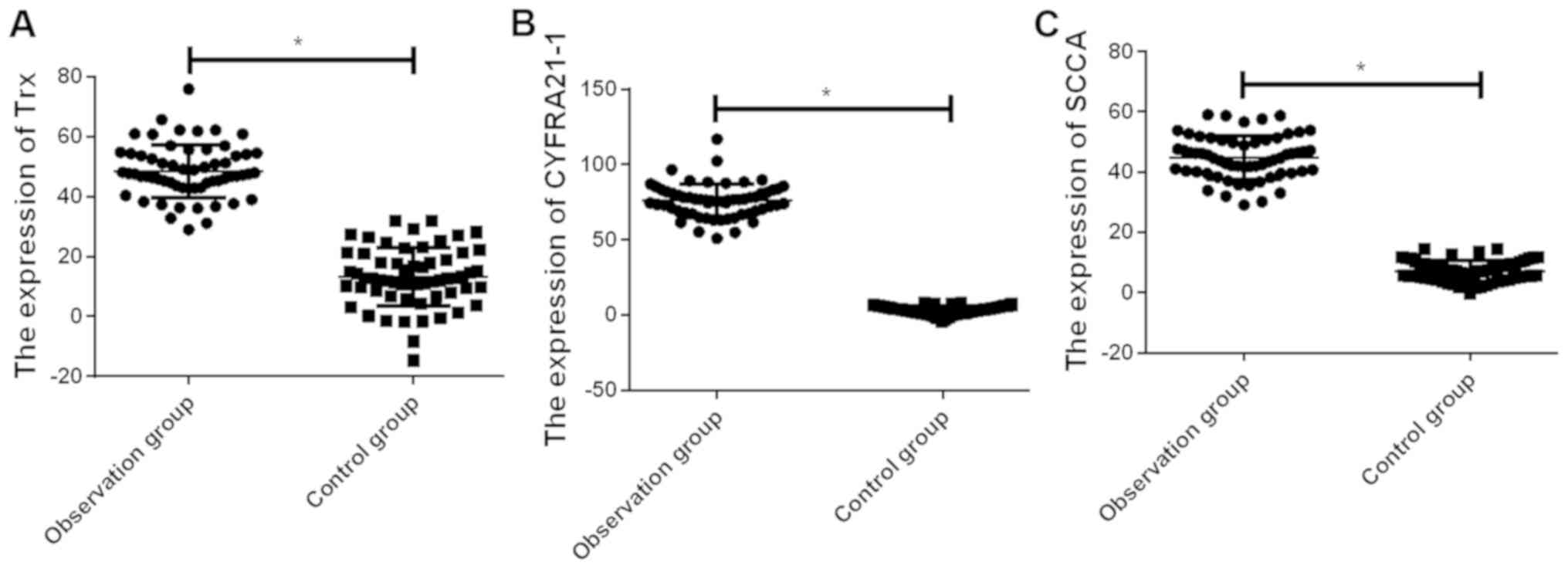|
1
|
Ferlay J, Soerjomataram I, Dikshit R, Eser
S, Mathers C, Rebelo M, Parkin DM, Forman D and Bray F: Cancer
incidence and mortality worldwide: Sources, methods and major
patterns in GLOBOCAN 2012. Int J Cancer. 136:E359–E386. 2015.
View Article : Google Scholar : PubMed/NCBI
|
|
2
|
D'Addario G, Früh M, Reck M, Baumann P,
Klepetko W and Felip E; ESMO Guidelines Working Group, : Metastatic
non-small-cell lung cancer: ESMO Clinical Practice Guidelines for
diagnosis, treatment and follow-up. Ann Oncol. 21 (Suppl
5):v116–v119. 2010. View Article : Google Scholar : PubMed/NCBI
|
|
3
|
Vansteenkiste J, Crinò L, Dooms C,
Douillard JY, Faivre-Finn C, Lim E, Rocco G, Senan S, Van Schil P,
Veronesi G, et al Panel Members, : 2nd ESMO Consensus Conference on
Lung Cancer: Early-stage non-small-cell lung cancer consensus on
diagnosis, treatment and follow-up. Ann Oncol. 25:1462–1474. 2014.
View Article : Google Scholar : PubMed/NCBI
|
|
4
|
Boonstra MC, de Geus SW, Prevoo HA,
Hawinkels LJ, van de Velde CJ, Kuppen PJ, Vahrmeijer AL and Sier
CF: Selecting targets for tumor imaging: An overview of
cancer-associated membrane proteins. Biomark Cancer. 8:119–133.
2016. View Article : Google Scholar : PubMed/NCBI
|
|
5
|
Liang B, Shao W, Zhu C, Wen G, Yue X, Wang
R, Quan J, Du J and Bu X: Mitochondria-targeted approach:
remarkably enhanced cellular bioactivities of TPP2a as selective
inhibitor and probe toward TrxR. ACS Chem Biol. 11:425–434. 2016.
View Article : Google Scholar : PubMed/NCBI
|
|
6
|
Negrin LL, Halat G, Kettner S, Gregori M,
Ristl R, Hajdu S and Heinz T: Club cell protein 16 and cytokeratin
fragment 21-1 as early predictors of pulmonary complications in
polytraumatized patients with severe chest trauma. PLoS One.
12:e01753032017. View Article : Google Scholar : PubMed/NCBI
|
|
7
|
Holdenrieder S, Molina R, Qiu L, Zhi X,
Rutz S, Engel C, Kasper-Sauer P, Dayyani F and Korse CM: Technical
and clinical performance of a new assay to detect squamous cell
carcinoma antigen levels for the differential diagnosis of
cervical, lung, and head and neck cancer. Tumour Biol.
40:10104283187722022018. View Article : Google Scholar : PubMed/NCBI
|
|
8
|
Nakamura H and Nishimura T: History,
molecular features, and clinical importance of conventional serum
biomarkers in lung cancer. Surg Today. 47:1037–1059. 2017.
View Article : Google Scholar : PubMed/NCBI
|
|
9
|
Shen YW, Zhang XM, Li ST, Lv M, Yang J,
Wang F, Chen ZL, Wang BY, Li P, Chen L, et al: Efficacy and safety
of icotinib as first-line therapy in patients with advanced
non-small-cell lung cancer. OncoTargets Ther. 9:929–935. 2016.
View Article : Google Scholar
|
|
10
|
He WJ, Li WH, Jiang B, Wang YF, Xia YX and
Wang L: MicroRNAs level as an initial screening method for
early-stage lung cancer: A bivariate diagnostic random-effects
meta-analysis. Int J Clin Exp Med. 8:12317–12326. 2015.PubMed/NCBI
|
|
11
|
Arjune S, Schwarz G and Belaidi AA:
Involvement of the Cys-Tyr cofactor on iron binding in the active
site of human cysteine dioxygenase. Amino Acids. 47:55–63. 2015.
View Article : Google Scholar : PubMed/NCBI
|
|
12
|
Zheng X, Xu W, Sun R, Yin H, Dong C and
Zeng H: Synergism between thioredoxin reductase inhibitor ethaselen
and sodium selenite in inhibiting proliferation and inducing death
of human non-small cell lung cancer cells. Chem Biol Interact.
275:74–85. 2017. View Article : Google Scholar : PubMed/NCBI
|
|
13
|
You BR, Kim SH and Park WH: Reactive
oxygen species, glutathione, and thioredoxin influence suberoyl
bishydroxamic acid-induced apoptosis in A549 lung cancer cells.
Tumour Biol. 36:3429–3439. 2015. View Article : Google Scholar : PubMed/NCBI
|
|
14
|
Dohmoto K, Hojo S, Fujita J, Yang Y, Ueda
Y, Bandoh S, Yamaji Y, Ohtsuki Y, Dobashi N, Ishida T, et al: The
role of caspase 3 in producing cytokeratin 19 fragment (CYFRA21-1)
in human lung cancer cell lines. Int J Cancer. 91:468–473. 2001.
View Article : Google Scholar : PubMed/NCBI
|
|
15
|
Liu L, Teng J, Zhang L, Cong P, Yao Y, Sun
G, Liu Z, Yu T and Liu M: The combination of the tumor markers
suggests the histological diagnosis of lung cancer. BioMed Res Int.
2017:20139892017.PubMed/NCBI
|
|
16
|
Zhao W, Yu H, Han Z, Gao N, Xue J and Wang
Y: Clinical significance of joint detection of serum CEA, SCCA, and
bFGF in the diagnosis of lung cancer. Int J Clin Exp Pathol.
8:9506–9511. 2015.PubMed/NCBI
|
|
17
|
Chen F, Wang XY, Han XH, Wang H and Qi J:
Diagnostic value of Cyfra21-1, SCC and CEA for differentiation of
early-stage NSCLC from benign lung disease. Int J Clin Exp Med.
8:11295–11300. 2015.PubMed/NCBI
|
|
18
|
Chen MS, Xu Y, Ma J, Wu CG, Hao XK, Lu BB
and Liu T: Relation between the level of TPS, NSE, CEA and beta2-mG
in the serum and the biological behavior of small cell lung cancer.
Xi Bao Yu Fen Zi Mian Yi Xue Za Zhi. 23:751–753. 2007.(In Chinese).
PubMed/NCBI
|
|
19
|
Schmidt B, Beyer J, Dietrich D, Bork I,
Liebenberg V and Fleischhacker M: Quantification of cell-free
mSHOX2 Plasma DNA for therapy monitoring in advanced stage
non-small cell (NSCLC) and small-cell lung cancer (SCLC) patients.
PLoS One. 10:e01181952015. View Article : Google Scholar : PubMed/NCBI
|
|
20
|
Jiang ZF, Wang M and Xu JL: Thymidine
kinase 1 combined with CEA, CYFRA21-1 and NSE improved its
diagnostic value for lung cancer. Life Sci. 194:1–6. 2018.
View Article : Google Scholar : PubMed/NCBI
|
|
21
|
Zhang L, Liu D, Li L, Pu D, Zhou P, Jing
Y, Yu H, Wang Y, Zhu Y, He Y, et al: The important role of
circulating CYFRA21-1 in metastasis diagnosis and prognostic value
compared with carcinoembryonic antigen and neuron-specific enolase
in lung cancer patients. BMC Cancer. 17:962017. View Article : Google Scholar : PubMed/NCBI
|












